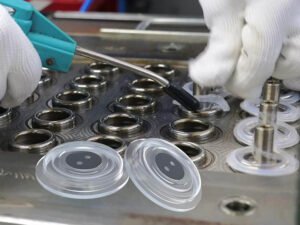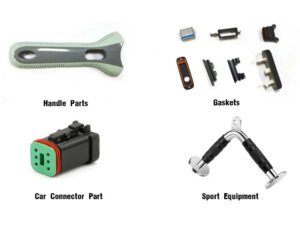Silicone overmolding involves bonding silicone materials to a substrate to create integrated parts. The primary material used in this process is liquid silicone rubber (LSR), which offers excellent flow properties for precise injection. However, other forms exist, including high-temperature vulcanizing (HTV) silicone for applications requiring higher hardness or lower costs, and room-temperature vulcanizing (RTV) silicone suited for low-volume prototypes. This versatility in materials allows silicone overmolding to adapt to various production needs, from high-precision components to durable consumer products.
What is Silicone Overmolding?
Silicone overmolding is a manufacturing technique where silicone is applied over a pre-formed substrate to form a single, unified component. In practice, it combines rigid bases with flexible silicone layers. The silicone rubber overmolding process ensures strong adhesion without separate adhesives in most cases.

Advantages of Silicone Materials in Overmolding
Liquid silicone rubber offers many benefits in the silicone overmolding.
Wide Color Selection: LSR comes in translucent forms or custom colors and tints. This allows for detailed designs and finishes that improve appearance in consumer goods and medical products.
Great Temperature Resistance: One of the most distinctive features of liquid silicone is its stability across a broad temperature range. LSR maintains its flexibility and mechanical strength even in extreme environments, performing reliably in both high-heat and low-temperature applications.
Durability: LSR resists wear, tear, and aging. This supports extended service life in demanding settings.
Biocompatibility: Medical-grade silicone is biocompatible, hypoallergenic, and compliant with FDA and ISO standards. It ensures that the final product is safe, non-toxic, and suitable for direct contact with human skin or biological tissues.
Functional versatility: LSR overmolding merges rigid and flexible elements. The silicone provides cushioning, sealing, or anti-slip functionality, while the rigid substrate offers structural support. This combination improves overall product performance and utility.
Chemical and Environmental Resistance: Silicone is highly resistant to moisture, UV radiation, ozone, and many chemicals. This resistance ensures that silicone overmolded parts remain functional even in harsh or outdoor environments.
Types of Silicone Overmolding
Silicone overmolding can be categorized based on the substrate material, each offering specific functional improvements.

Silicone Over Plastic
This is the most common form of liquid silicone overmolding. A pre-molded plastic part, such as PC, ABS, or nylon, serves as the substrate. LSR is injected onto it to create a soft exterior layer. This type is common in consumer electronics housings, providing grip enhancement and water resistance through liquid silicone overmolding.
Silicone over Metal
Here, the substrate is a metal component such as aluminum or stainless steel. The silicone layer provides insulation, anti-slip grip, vibration damping, and sealing properties. Silicone rubber overmolding on metal parts is frequently applied in automotive and industrial tools.
Silicone over Silicone
Multiple silicone layers with varying hardness levels are bonded. This approach allows designers to achieve multi-color or multi-durometer effects, creating complex, high-performance silicone assemblies.
Silicone over Other Materials
Substrates include fabrics for flexible seals, ceramics for high-heat resistance, or electronic components for protective encapsulation in the overmolding silicone process.
The Silicone Overmolding Process
The silicone overmolding process follows a structured sequence to ensure quality and consistency.
- Material Selection: LSR is selected based on Shore hardness (20-80A 20-80A) and substrate compatibility. Primers or plasma treatments may be applied to improve adhesion in challenging cases.
- Mold Design and Fabrication: The mold must accommodate both the substrate and the injected silicone. It is designed to hold the pre-molded insert securely and to allow for uniform silicone flow. Key design features include venting channels, locking mechanisms, and temperature-controlled cavities.
- Molding and Curing: The prepared substrate is placed into the mold, and liquid silicone rubber is injected at a controlled temperature and pressure. Inside the mold, the silicone cures — typically through a heat-induced cross-linking reaction — forming a durable, elastic layer that adheres tightly to the substrate.
- Post-Processing: After molding, the part is demolded and may undergo additional operations such as trimming, surface finishing, or post-curing. Quality inspection checks for bonding integrity, flash, and dimensional accuracy to ensure consistent product performance.
Industries Suitable for Silicone Overmolding Technology
Because of its versatility and performance advantages, liquid silicone rubber overmolding is applied across a wide range of industries.
Medical and Healthcare
Surgical instruments, handheld devices, and implants use medical-grade silicone overmolding for biocompatibility and sterilizability, lowering infection risks.
Automotive Industry
Silicone’s resistance to heat, oil, and UV exposure makes it suitable for under-hood seals, buttons, gaskets, and vibration-damping parts. Silicone overmolding also improves tactile feel in interior controls such as switches and grips.
Consumer Electronics
Overmolding silicone onto plastic or metal casings enhances product durability and water resistance. It also offers a pleasant soft-touch exterior for smartphones, earbuds, and remote controls.
Personal Care and Beauty Devices
Products such as electric toothbrushes, shavers, and skincare tools often feature silicone rubber overmolding to deliver ergonomic comfort and a sleek appearance.
Baby Care
Bottle caps, teething toys, and pacifiers rely on food-grade silicone rubber overmolding for safety and softness.
Conclusion
Silicone overmolding is more than a surface treatment, it is a sophisticated molding technology that enables the integration of different materials into unified, high-performance products. The overmolding process improve various industries with durability, safety and user-friendly design. Zhongde provide kinds of silicone molding process service. Welcome to contact and get custom solution.


